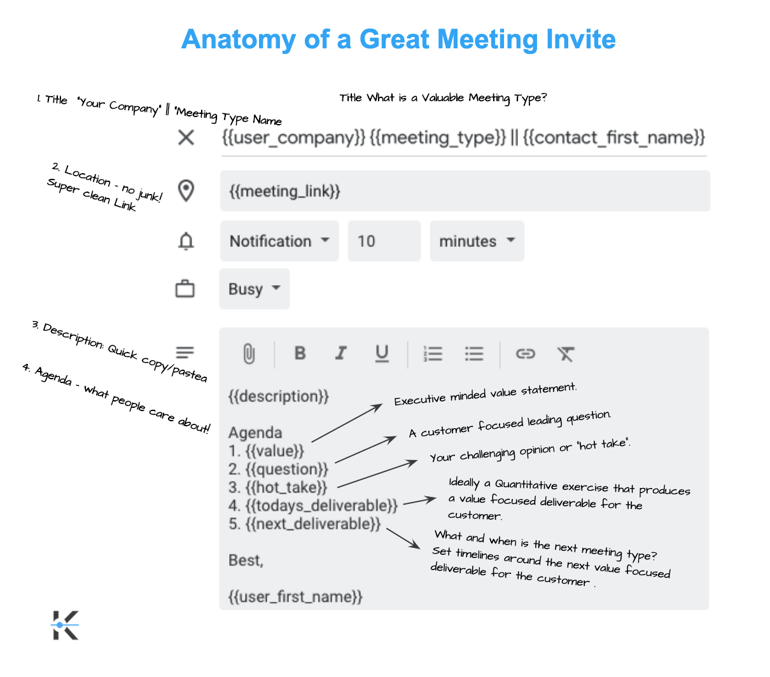
How much thought do you put into your meeting invites before you click “send”?
If you’re like most professionals, probably not a whole lot.
After all, by this point, you’ve already engaged with a prospect at least once, if not multiple times. They’re expecting the invitation, and all they’ll need to do is click “accept.” Why bother wasting precious time and energy on something so seemingly insignificant?
The truth is, like you, your prospects and customers are busy people who receive dozens of internal and external meeting invitations all week long. Their calendars fill up fast, and they have to be judicious with how they allocate their time. If they’re forced to choose between your meeting and someone else’s (which isn’t an unusual scenario), they’re going to opt for the meeting with the highest perceived value.
Your calendar invite is your final opportunity to communicate your value and lock down the call. Plus, crafting a compelling invitation can help you reach revenue goals, too. For example, if the average value of a meeting is $1,000, and you send out at least 4 invites per day, even a 10% increase in your acceptance rate would drive an extra $100,000 in revenue per year.
A great invitation will drive contacts to schedule the rest of their day around your meeting, rather than the other way around.
7 Common (and Deadly) Meeting Invite Mistakes
As you can imagine, we spend a lot of time analyzing meeting scheduling best practices here at Kronologic . I’ve seen a few great examples, but, for the most part, it’s a significant area of opportunity across businesses of every size and industry.
And although organizations frequently coach salespeople on email etiquette and creating messages that captivate their prospects, meeting invitations are rarely a part of those conversations.
Here are some of the most common mistakes:
- Boring agendas: Your agenda is an opportunity to list a few of the critical subjects you’ll tackle within your call, and should serve to intrigue your recipient. Unfortunately, most people create ambiguous agendas filled with un-sexy items like “Intros” and “Next Steps.” Be specific as possible.
- Lengthy descriptions: No one wants to read a huge block of text. In fact, they’re probably going to skip past it anyway. Instead, include a one or two-sentence intro and get to the agenda as quickly as possible.
- Vague titles: Please stop calling every meeting a “sync.” Instead, call it what it is. (I.e., A demo, a needs analysis, a quarterly business review, a roadmapping session, etc.) If all else fails and you’re unsure how to classify a simple one-on-one meeting, just stick to names: “[Recipient Name] and [Your Name].”
- Failing to define responsibility: If you’re not using Zoom, WebEx, or another conferencing software, it’s crucial you determine who will call whom and at what number. (E.g., “Maria to call Joe at 512-555-1234.”)
- Pasting the entire invite from your conferencing scheduler: This is a great way to clog up your invitation with a ton of unnecessary information and confuse your recipient. Instead, distill it down to the bare essentials. (I.e., Don’t include the international number if your contact isn’t international, and leave out the bridge.)
- Creating too many steps: In most cases, creating a unique meeting and requiring a passcode for each session is unnecessary and only serves to complicate the experience. Instead, use a fixed meeting link for all your meetings. If you’re worried about prospects joining early and overhearing your call with someone else, you can switch the setting that prevents people from entering early. (Zoom and Webex call this a “waiting room.”)
- Get it on the calendar!: When in doubt, just send over an invite. Instead of asking someone if a couple of times work for them, simply send them an invite for a specific time and then give them a fallback option(s) in an email. If they want to talk, recipients will usually accept. Think of it as a negotiation, and your initial offer is “Hey, I want to give you this specific value at this specific time, all you have to do is click ‘Accept’”. It’s just the polite thing to do – especially for busy professionals.
If you’re guilty of committing any of these seven mistakes, don’t worry — it’s an easy fix.
Here’s how to craft powerful meeting invites:
The Anatomy of a Great Meeting Invite
Most meeting invites are awful — but that’s great news! It means you have an opportunity to stand out from the slew of low-quality invites your prospects are accustomed to receiving.
Here’s everything you need to include in your invitations:
- Title/topic
Give your meeting a short, snappy title that makes sense to your recipient — and remember to be as specific as possible.
Here’s my go-to formula:
[PROPER NOUN] + [TYPE OF MEETING] + [SEPARATOR] + [RECIPIENT NAME] + [YOUR NAME]
Example: Kronologic Demo — Joe and Trey - Location
Unless this is a physical meeting where you’ll need to list an office and conference room, it’s best to use this spot for your meeting link. - Description
Start with a one or two-sentence intro, then get straight to your agenda. I find it’s helpful to include the following elements:
Question: Share a question you’ll answer.
Opinion: State an opinion you’ll provide.
Value proposition: Tease your value proposition.
Desired outcome: Close with well-defined next steps. (It’s important not to be too assumptive. But you should be transparent. If your prospect isn’t ready for the next steps, then the call might be a waste of time for everyone involved.)
Example:
Hi Joe, I’m looking forward to our call Tuesday! I’ve included my Zoom link and agenda below. Please let me know if there’s anything else you’d like to discuss.
Thanks!
Agenda:
- What is your average value per meeting
- How you compare to your industry
- How Kronologic can help you monetize and automate your team’s calendars
- Set up proposal review
It’s easy to disregard your meeting invites when you’re being pulled in a thousand other directions. But poor invitation habits can cost your business thousands (or millions) over the course of the year in lost opportunities — which will impact your ability to meet your revenue target. This one simple habit can make or break your numbers.
That’s why, when it comes to composing your meeting invites, it’s crucial you put yourself in your recipients’ shoes. So long as your invites are concise, acknowledge customer pain points and goals, demonstrate real value, and you provide a fast-and-easy way to join the call, you’ll gain a significant edge over anyone else vying for your prospects’ time.
This post was originally published by AA-ISP, and is republished here with permission.
Learn more about what Kronologic can do for you:
Originally published Mar 10, 2020 9:00:00 AM, updated

Written by Trey Allison
Trey grew up in Marfa, TX playing with airplanes and minimalism. He attended both UT Austin and Texas A&M, where he founded a fraternity, established a campus newspaper, launched a 3D printing lab — and changed majors often. He graduated with a Bachelor's degree, a couple of minors, completed pre-med requirements, and a nuclear reactor operator’s license. Trey jumped into Fortune 500 Tech and traveled the country for four years as an enterprise VMware consultant before co-founding Kronologic with Ben Parker. After bootstrapping their way to revenue, they met fellow co-founders Chris Lee and Aaron Bollinger, grew their customer base, raised additional funding, hired top talent, hustled, hustled more (and repeat). Trey is now having the time of his life.

